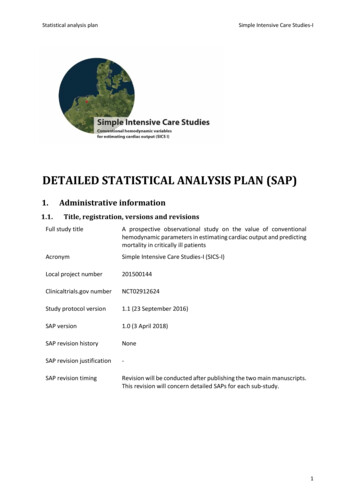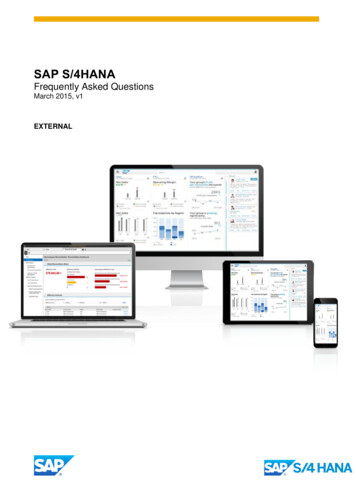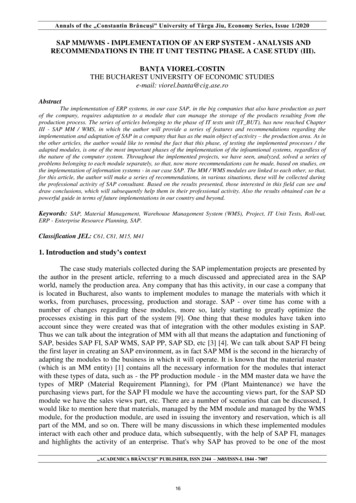
Transcription
Statistical analysis planSimple Intensive Care Studies-IDETAILED STATISTICAL ANALYSIS PLAN (SAP)1.1.1.Administrative informationTitle, registration, versions and revisionsFull study titleA prospective observational study on the value of conventionalhemodynamic parameters in estimating cardiac output and predictingmortality in critically ill patientsAcronymSimple Intensive Care Studies-I (SICS-I)Local project number201500144Clinicaltrials.gov numberNCT02912624Study protocol version1.1 (23 September 2016)SAP version1.0 (3 April 2018)SAP revision historyNoneSAP revision justification-SAP revision timingRevision will be conducted after publishing the two main manuscripts.This revision will concern detailed SAPs for each sub-study.1
Statistical analysis plan1.2.Simple Intensive Care Studies-IRoles and responsibilityAuthorBart Hiemstra1StatisticianIlja M. Nolte2Principle investigatorIwan C.C. van der Horst1Contributors and rolesPim van der Harst3: revised the SAPFrederik Keus1: contributed to the design and revised the SAPHarold Snieder2: revised the SAPChris HL Tio2: main contributor to the section ‘missing data’José N Alves Castela Cardoso Forte1: drafted the section ‘additionalanalyses: machine learning’Jørn Wetterslev4: contributed to the design and revised the SAP. Maincontributor to the sections ‘sample size, power, and detectabledifference’ and ‘statistical significance and multiple testing’Affiliations1. Department of Critical Care, University of Groningen, UniversityMedical Center Groningen, Groningen, The Netherlands2. Department of Epidemiology, University of Groningen, UniversityMedical Center Groningen, Groningen, The Netherlands3. Department of Cardiology, University of Groningen, UniversityMedical Center Groningen, Groningen, The Netherlands4. The Copenhagen Trial Unit (CTU), Centre for Clinical InterventionResearch, Copenhagen, Denmark2
Statistical analysis plan1.3.Simple Intensive Care Studies-ISignaturesWe the undersigned, certify that we read this SAP and approve it as adequate in scope of the mainanalyses of the me:.Date:1.3.3.Principle investigatorName:.Date:3
Statistical analysis plan2.2.1.Simple Intensive Care Studies-IIntroductionBackground and rationaleAbout one-third of all critically ill patients suffer from circulatory shock, which places them at increasedrisks of multi-organ failure, long-term morbidity, and mortality (1,2). Combinations of clinical,haemodynamic and biochemical variables are recommended for establishing the diagnosis andinstigation of treatment (3,4). If necessary, more advanced and sequential haemodynamicassessments using critical care ultrasound (CCUS) as preferred modality are recommended (3-6).Clinical examination in the critically ill comprises frequent measurement of heart rate, blood pressure,body temperature, skin perfusion, urine output and mental status (3). Daily use of clinical examination(in any patient) for diagnostic purposes contrasts with the limited number and quality of studies, sothat the level of evidence for use of clinical examination in the critically ill is considered best practice(3). Previous studies have suggested different prognostic or diagnostic variables and many studies haveanalysed single or dual variable associations, while no research has evaluated their additional value ontop of the accepted predictors (7). The reason for inconsistency of results in these studies potentiallyoriginate from several methodological flaws, including improper research design, lack of confirmationcohorts, and power and sample size issues.The additive diagnostic and prognostic value of combinations of clinical, biochemical andhaemodynamic variables remains to be established with a higher quality of evidence. These variableshave never been evaluated collectively in a large, broad, prospective cohort of critically ill patients.Therefore, we established the Simple Intensive Care Studies I (SICS-I) with the aim to evaluate thediagnostic and prognostic value of a comprehensive selection of clinical and haemodynamic variablesin the critically ill (7).Prospective registration of protocols of observational studies are promoted to prevent outcomereporting bias (8,9). Likewise, prospective publication of a detailed statistical analysis plan (SAP) isencouraged to prevent data-driven analyses (9-11).2.2.Objectives2.2.1.Objectives and research questionsThe objective of the SICS-I study was to establish a cohort with a dual aim: to evaluate the (1) diagnosticand (2) prognostic value of a comprehensive selection of clinical examination, haemodynamic andbiochemical variables in the critically ill. More specific, the two research questions of the basic studywere (1): which combination of clinical examination findings is associated with cardiac index measured4
Statistical analysis planSimple Intensive Care Studies-Iwith CCUS? And (2): which combination of clinical examination, haemodynamic and biochemicalvariables is associated with 90-day mortality?In the basic study of the SICS we collected a broad number of clinical examination, haemodynamic andbiochemical variables, and used CCUS to only measure cardiac output. The infrastructure and designenabled (temporarily) addition of sub-studies in which additional variables were collected. Researchquestions of the sub-studies all address the overall aim of the SICS-I cohort (table 1).2.2.2.HypothesesThe hypothesis of research question 1, i.e. the diagnostic study, are: Null hypothesis: there is no true correlation between any single or a combination of clinicalexamination findings and cardiac index measured with CCUS Alternative hypothesis: cardiac index measured with CCUS is associated with one or acombination of clinical examination findingsThe hypothesis of research question 2, i.e. the prognostic study, are: Null hypothesis: clinical examination, biochemical and haemodynamic variables are notassociated with 90-day mortality Alternative hypothesis: clinical examination, haemodynamic and biochemical variables areassociated with 90-day mortality2.2.3.ScopeThis SAP will be the guiding document for the analyses that will be conducted in the basic study. Weintend to present the results of the two primary aims in separate manuscripts. All the aims andresearch questions of the sub-studies will be included in the appendix of this SAP, and we aim topresent the SAPs of the sub-studies as an addendum in the future.5
Statistical analysis plan3.3.1.Simple Intensive Care Studies-IStudy methodsGeneral study design and planThe SICS-I is a prospective cohort study which is conducted in the department of critical care of theUniversity Medical Center Groningen (UMCG). The entire study was purely observational in design; nointerventions were applied as part of the study protocol.The protocol of this study was published on the website of the department of critical care of ourhospital before the start of the study (Project number: 201500144) and registered at clinicaltrials.gov(NCT02912624). This analysis plan has been written while data collection was ongoing, but before fullaccess to the study database. For our design paper, we only extracted baseline data and we did nothave access to the validated outcome data.3.2.Sample size, power and detectable differenceThere are no previous studies which included combinations of clinical examination, haemodynamicand biochemical variables into one model for estimation of cardiac output and mortality. This makesit difficult to calculate sample size based on previous literature. Alternatively, we made an estimationof the power of our multivariable models given the set sample size of our cohort.3.2.1.Diagnostic studyWe are planning our main analysis with 1075 patients in which we will regress their values of cardiacindex against clinical examination findings. For this power calculation, we used the clinical examinationvariables urine output and capillary refill time an example (7). In our design paper, the SD of cardiacindex was 0.99 and the SD of urine output was 0.98, with a slope estimate of 0.040 obtained whencardiac index was regressed against urine output. The SD of capillary refill time was 2.4, with a slopeestimate of -0.045 obtained when cardiac index was regressed against capillary refill time. If the trueslope of the line obtained by regressing cardiac index against urine output or capillary refill time is0.10, we will be able to reject the null hypothesis that this slope equals zero with probability (power)0.81 for urine output, and 1.00 for capillary refill time. The type I error probability associated with thistest of this null hypothesis is 0.015 (see paragraph 6.6 below).3.2.2.Prognostic studyWe are planning our main analysis with 1075 patients and take skin mottling as example for our powercalculation: in our design paper, 46% of the patients has skin mottling. If we assume a similarproportion in our total cohort, we have 495 patients with skin mottling and 580 without. Pilot datafrom our design paper indicate that the 30-day mortality proportion among controls is 0.18 (7). If thetrue mortality proportion for patients with skin mottling is 0.27, we will be able to reject the null6
Statistical analysis planSimple Intensive Care Studies-Ihypothesis that the mortality proportion for patients with skin mottling and control patients are equalwith probability (power) 0.84. The type I error probability associated with this test of this nullhypothesis is 0.015. We will use an uncorrected chi-squared statistic to evaluate this null hypothesis.3.3.Timing of final analysisData cleansing and CCUS image validation will be performed upon completion of the 90-day follow-upof the last patient included in the study. The final analysis will be conducted hereafter.This statistical analysis plan was added to the study protocol at clinicaltrials.gov, before closure of thedatabase and before any analyses had been conducted. Independent study monitoring was conductedin adherence to the Good Clinical Practice guidelines (10).3.4.Timing of outcome assessmentsFollow-up on all-cause mortality was conducted at 1 November 2017, i.e. 90-days after the inclusionof the last patient.7
Statistical analysis plan4.Simple Intensive Care Studies-IStatistical principles4.1.MultiplicityThe diagnostic and prognostic basic study and each sub-study consist of one primary outcome and oneor more secondary, exploratory outcomes. We will encounter multiplicity issues due to the multipleprimary outcomes that are tested for significance in the same cohort. The SICS-I cohort addresses sixdifferent primary outcomes (table 2, last column); two primary outcomes of the basic study (diagnosticand prognostic), and four additional outcomes in the nine sub-studies.We will apply an adjustment for multiplicity based on the total numbers of different primary outcomestested. Our cohort mainly addresses haemodynamic research questions, so that most outcomes willprobably be positively correlated. Therefore, a Bonferroni adjustment of the P-value might be tooconservative. We chose for multiplicity adjusted thresholds by following the pragmatic approachstated by Jakobsen et al. (12). The authors suggested that the ‘true’ threshold lies somewhere betweenthe unadjusted threshold (most often 0.05) and the Bonferroni adjusted threshold. Where in thisinterval the ‘true’ threshold is placed is dependent on the correlation between the outcomes, if twooutcomes are perfectly correlated (a correlation coefficient of 1) no adjustment of the threshold forstatistical significance is needed, if two outcomes are totally independent (a correlation coefficient of0) a full Bonferroni adjustment is needed. Therefore, Jakobsen et al suggest “dividing the pre-specifiedP-value threshold with the value halfway between 1 (no adjustment) and the number of primaryoutcome comparisons (full Bonferroni adjustment)” as such an adjustment will come closer to the‘true’ statistical significance level than the ‘extreme thresholds’ in a majority of situations (12). Thecorresponding formula ���𝑜𝑜𝑜 𝑓𝑓𝑓𝑓𝑓𝑓 ��𝑠𝑠𝑠𝑠𝑠𝑠𝑠𝑠𝑠𝑠𝑠 Wherein:𝛼𝛼𝑚𝑚 1 2 α is the unadjusted threshold for significance, usually 0.05 m is the number of primary outcomes or tests (used) in the same cohort (in this case: six)The threshold for significance in the SICS-I cohort will ���𝑜𝑜𝑜 𝑓𝑓𝑓𝑓𝑓𝑓 ��𝑠𝑠𝑠𝑠𝑠𝑠𝑠𝑐𝑐𝑒𝑒 0.05 0.0143 0.0156 1 28
Statistical analysis plan4.2.Simple Intensive Care Studies-IStatistical significance and confidence intervalAs calculated in 4.1, we will consider a P 0.015 as statistically significant for our primary outcomes.When we find a 0.015 P 0.05, we will consider this association of dubious significance and willemphasise the increased chance of a type I error. Results will be presented with their values (e.g.regression coefficients, odds ratios, etc.) with 98.5% confidence intervals.4.3.4.3.1.Adherence and protocol deviationsDefinitions of protocol deviationsProtocol deviations are defined when the activities on a study diverge from the local institutionalreview board-approved protocol, however without significant consequences (13).4.3.2.Protocol deviations to be summarisedWe opted for the following subgroup analyses in our study protocol: different types of shock(distributive, obstructive, hypovolemic, cardiogenic), CVVH, heart failure by any cause, myocardialinfarction, atrial fibrillation or surgery versus no-surgery patient groups.We decided to replace these proposed subgroup analyses by the subgroups described in section 6.3.We believe that these subgroups agree better with the perspective from which a physician approachesa critically ill patient.9
Statistical analysis plan5.Simple Intensive Care Studies-IStudy population5.1.Screening dataEligible patients who were not included will be compared to included patients by comparing theirgeneral characteristics (age, sex), and SAPS-II and APACHE-IV scores.5.2.EligibilityAll eligible patients were included on their first day of ICU admission. Inclusion in the basic studyconsisted of a protocolised clinical examination and subsequent CCUS. The attending ICU physicianestimated the expected duration of ICU treatment. Patients expected to stay beyond 24 hours whowere eventually discharged within 24 hours were included in our main analyses.5.2.1.Inclusion criteria Emergency admission Expected stay 24 hours5.2.2.Exclusion criteria Age 18 years Planned admission (either after surgery or for other reasons) Unable to obtain informed consent, e.g. refusal, acute psychiatric disorders, mentalretardation, serious language barriers 5.3.Continuous resuscitation efforts or mechanical circulatory supportRecruitmentA flow diagram will be used to visualise the flow of patients. In this flow diagram, we will report thepopulation from which the eligible patients were selected, reasons for exclusion of eligible patients,and how many CCUS images and measurements were validated (diagnostic study) or how manypatients died (prognostic study). See figure 1 for an example of our flow diagram.5.4.Withdrawal/follow-up5.4.1.Level and timing of withdrawalThe withdrawal rate of the SICS-I is below 2%, since it was an observational study in which nointerventions were applied.Following hospital regulations, patients or their legal representatives were informed and wereexcluded if they refused to participate. Withdrawal from our study occurred when informed consentwas obtained from the patient’s legal representative, but the patient refused at a later time.10
Statistical analysis plan5.4.2.Simple Intensive Care Studies-IReasons and details of withdrawalReasons for withdrawal or lost to follow-up will be reported in the manuscript and/or flow diagram.Our observational study consists of a one-time measurement (snapshot), so that drop-outs or lost tofollow-up reasons are unrelated to the study.Patients who were lost to follow-up are considered alive until their last outpatient visit or hospitaldischarge, and were censored thereafter.5.5.Baseline patient characteristics5.5.1.Collected baseline patient characteristicsThe cohort study was designed to register a set of clinical examination, biochemical andhaemodynamic variables in each included patient. We extracted baseline demographic data from theDutch National Intensive Care Evaluation (NICE) registry and collected clinical data by protocolisedclinical examination and CCUS. We obtained the biochemical values from arterial blood gas analysesclosest to study inclusion. Table 2 provides an overview of all collected variables and indicates for eachvariable whether it is categorised as a clinical examination, haemodynamic, or biochemical variable.5.5.2.Descriptive summarization of baseline patient characteristicsWe will list general patient characteristics in a baseline characteristics table. Data will be presented asmean with standard deviation (SD) when normally distributed or as median with interquartile range incase of skewed data. Dichotomous and categorical data will be presented in proportions. Normality ofthe data will be assessed using P-P plots, Q-Q plots, and histograms. Linearity will be assessed usingscatter plots. Differences between continuous variables will be assessed using Student’s t-tests orMann-Whitney-U test, depending on normality, whereas the Chi-squared test will be used forcategorical values. For repeated measurements, we will use the paired t-test for normally distributedcontinuous data, the Wilcoxon signed-rank test for skewed continuous data, and the McNemar testfor dichotomous data.5.6.Assumed confounding covariatesThe majority of variables measured in our study are inevitably correlated, as most relate to thehaemodynamic status of a patient. While definitions have been recorded in the protocol, the values ofthe variables can be confounded by unmeasured factors, such as environmental, genetic, orpsychological influences. Therefore, we provide an example of possible confounding variables andcategorise these into ‘measured’ and ‘unmeasured’.11
Statistical analysis plan Simple Intensive Care Studies-ICardiac output and clinical examination of the central haemodynamics (i.e. heart rate, bloodpressures, central venous pressure) are assumed to be confounded by: Measured: body surface area (therefore we will use cardiac index), quality ofmeasurements (therefore data will be validated), distributive shock as the underlyingpathology, administration of inotropes and/or vasopressors, administration ofpropofol (negative inotropic effect), mechanical ventilation including ventilationpressures Unmeasured: stress, pain, anxietyUrine production is assumed to be confounded by: Measured: history of chronic renal failure, distributive shock as the underlyingpathology AVPU score is assumed to be confounded by Unmeasured: total amounts of fluids administeredMeasured: sedation (propofol, midazolam)Clinical examination of peripheral perfusion (i.e. mottling, peripheral capillary refill times,peripheral temperatures) are assumed to be confounded by: Measured: heating blankets, distributive shock as the underlying pathology, cardiacoutput, administration of inotropes and/or vasopressors, administration of propofol(vasodilation) Unmeasured: regular blankets, environmental temperature, peripheral arterialdisease. Mortality proportion is assumed to be confounded by: Measured: age, comorbidities, and several other variables that are all embedded inthe simplified acute physiology score II (SAPS-II) score Unmeasured: cause of mortality (e.g., death due to multi-organ failure or failure towean, a patient’s or family’s personal wishes regarding the extent of ICU treatment.This will, however, always be a mix of causes).We acknowledge that there will be residual confounding in our dataset due to the presence ofunmeasured confounding, some of which is listed above. However, the actual measured variablesreflect daily practice and so, is assumed to reflect similar confounding in daily assessments of thehaemodynamic status of ICU patients.12
Statistical analysis plan6.Simple Intensive Care Studies-IAnalysis6.1.Outcome definitions6.1.1.Primary and secondary outcomesThe research questions and the design of the study have been published (7). We elaborate on theoutcomes of the basic study below and described the primary outcomes of each sub-study in appendix1.The outcomes of research question 1, i.e. the diagnostic study, are: Primary: the association of a single or combination of clinical examination findings with cardiacindex measured by CCUS Secondary: the diagnostic test accuracy of a single or a combination of clinical examinationfindings to diagnose a low, normal and high cardiac index Secondary: the association and diagnostic test accuracy of a single or combination of clinicalexamination findings with cardiac index in clinically different patient subgroupsThe outcomes of research question 2, i.e. the prognostic study, are: Primary: the association of all measured clinical examination, biochemical and haemodynamicvariables with 90-day mortality Secondary: the association of clinical examination, biochemical and haemodynamic variableswith 7-day and 30-day mortality Secondary: the association of clinical examination, biochemical and haemodynamic variablesthat are not visible to caregivers with 90-day mortality Secondary: the association of clinical examination, biochemical and haemodynamic variableswith 90-day mortality in clinically different patient subgroups6.1.2.Measurement and calculation of outcomesFor the diagnostic study we calculated cardiac index, which was derived from cardiac output. Cardiacoutput has been measured with the cardiac probe M3S of M4S with default cardiac imaging setting ofthe General Electric Vivid-S6 mobile ultrasound machine. Two views were obtained: the parasternallong axis (PLAX) and the apical five chamber view (AP5CH). The PLAX was used as the primary view tomeasure the left ventricular outflow tract (LVOT) diameter. The AP5CH view was used to measure thevelocity time integral (VTI) using the pulse wave Doppler signal in the LVOT. Cardiac output wascalculated on the ultrasound machine according to the formula:13
Statistical analysis planSimple Intensive Care �𝐶𝐶𝐶𝐶𝐶𝐶 𝑜𝑜𝑜𝑜𝑜𝑜𝑜𝑜𝑜𝑜𝑜𝑜 () ℎ𝑒𝑒𝑒𝑒𝑒𝑒𝑒𝑒 𝑟𝑟𝑟𝑟𝑟𝑟𝑟𝑟 𝑉𝑉𝑉𝑉𝑉𝑉 𝜋𝜋 𝐿𝐿𝐿𝐿𝐿𝐿𝐿𝐿 𝑚𝑚𝑚𝑚𝑚𝑚2At a later time, the images and measurements were validated by technicians from an independentcore laboratory, whom were blinded for all other measurements and outcomes.We used cardiac index instead of cardiac output for interindividual comparisons. Cardiac index is thecardiac output adjusted for body surface ���𝐶𝐶𝐶𝐶 𝐶𝐶𝐶𝐶𝐶𝐶𝐶 𝑖𝑖𝑖𝑖𝑖𝑖𝑖𝑖𝑖𝑖 ( 2 ) 𝑚𝑚𝐵𝐵𝐵𝐵𝐵𝐵𝐵𝐵 ��𝑠 𝑎𝑎𝑎𝑎𝑎𝑎𝑎𝑎Where body surface area was calculated with the DuBois formula (14):𝐵𝐵𝐵𝐵𝐵𝐵𝐵𝐵 ��𝑠 𝑎𝑎𝑎𝑎𝑎𝑎𝑎𝑎 0.007184 𝑊𝑊𝑊𝑊𝑊𝑊𝑊𝑊ℎ𝑡𝑡 0.425 𝐻𝐻𝐻𝐻𝐻𝐻𝐻𝐻ℎ𝑡𝑡 0.725Cut-offs for a low cardiac index for critically ill patients are inconsistent (15). Haemodynamic criteriato diagnose cardiogenic shock vary from a cardiac index of 1.8 to 2.5 L/min/m2 (16-19). A cardiac indexbelow 2.2 L/min/m2 is often used to diagnose a low cardiac output syndrome after cardiac surgery(20), whereas a large clinical trial used a cut off below 2.5 L/min/m2 in patients with acute lung injury(19). These criteria, however, apply to patients with heart failure or after cardiac surgery. Therecurrently is no consensus on how much cardiac index is low, normal or high for the critically ill patient.In the secondary outcome of our diagnostic study, we will both use a cut-off of 2.2 and 2.5 L/min/m2for a low, and a cut-off of 4.0 and 4.5 L/min/m2 for a high cardiac index.For the prognostic study we obtained follow-up on all-cause mortality from the municipal personalrecords database. Analysis of mortality will be performed using time-to-event data (patients werecensored at 90-days of follow-up).6.2.Analysis methods6.2.1.CorrelationsWe will use the Pearson r correlation and Spearman correlation coefficient rho (r) to evaluate thedegree of relationship between variables. For normally distributed variables, we will use the Pearsonr correlation with 98.5% confidence interval upon checking for linearity and homoscedasticity, whilein case of skewed, ordinal data, the degree of association between variables will be quantified usingSpearman correlation coefficient rho (r). We will use Cohen’s d to evaluate the correlation coefficientand assess the strength (or effect size) of the relationships, where a correlation coefficient between14
Statistical analysis planSimple Intensive Care Studies-I0.10 and 0.29 will represent a small association, between 0.30 and 0.49 a medium association, and acoefficient of 0.50 and above a large association.6.2.2.Continuous and dichotomous outcomes (diagnostic study)We will conduct a least-squares linear regression analysis for continuous dependent variables and alogistic regression for dichotomous dependent variables. A univariable regression analysis will beconducted on 17 clinical examination findings with cardiac index as the dependent variable. Aunivariable regression analysis will be conducted on all variables and a p 0.25 will be used forinclusion in the multivariable model. As there are no previous studies that include (a combination of)all available clinical examination variables into one model estimating cardiac index, we will not includeany variable on a theory driven basis. We will construct the multivariable model using forward stepwiseregression by adding blocks of variables. In case of a multivariable linear regression model, we willconstruct a kernel density plot to assess normality of the residuals and check the homogeneity ofvariance by plotting the residuals versus the fitted values. We will use the variance inflation factor (VIF)to check for multicollinearity; as a rule of thumb, we will assume multicollinearity when a variable hasa VIF-value greater than 10. If the assumptions are not met, we will use an ordinal regression analysis.6.2.3.Time-to-event data (prognostic study)Analysis of mortality will be performed using time-to-event data (patients were censored at 90-daysof follow-up). Categorical variables will be analysed using the log-rank test and continuous variableswill be assessed using a univariable Cox proportional hazard regression analysis. Analysis of mortalityproportion will be presented by Kaplan-Meier survival curves when independent variables aredichotomous or categorical. A univariable Cox regression analysis will be conducted on 22 clinicalexamination, haemodynamic and biochemical variables with 90-day mortality as the dependentvariable. Covariates with a of p 0.25 in the univariable analysis will be included in the multivariablemodel. We will include the SAPS-II score in our multivariable Cox regression model of 90-day mortality.The SAPS-II is a predictive score for in-hospital mortality and includes seventeen covariates amongwhich age, haemodynamic and biochemical variables, and presence of metastatic or haematologicalcancer (21). The proportionality assumption will be tested by using the Schoenfeld and scaledSchoenfeld residuals. We will test the proportionality of the model as a whole and the proportionalityfor each predictor and reject proportionality in case of significant test findings (p 0.05). We will plotgraphs of the scaled Schoenfeld assumption, where horizontal lines in the graph indicate that theproportionality assumption is not violated. We will also construct log-log plots, where two parallel linesindicate that proportionality was not violated. The goodness of fit of the final model will be evaluated15
Statistical analysis planSimple Intensive Care Studies-Iby using the Cox-Snell residuals. In our Cox regression models, at least 15 events are necessary for eachvariable included in the final model (22,23).6.2.4.Validation (both)Because of the fixed sample size of our study, we will use bootstrapping validation to assess theaccuracy of our model. We will randomly select 1075 individuals from the dataset with replacement,build our model on the bootstrapped sample and validate it on the original data. We will repeat thisprocess 100 times and include a variable into our final model if it was significant in at least 80 models.We will still emphasise the hypothesis-generating aspect of our findings. We aim to validate ourfindings in an independent cohort in the future.6.3.Sensitivity and subgroup analysesIn the diagnostic study, we will conduct a sensitivity analyses on the subgroup of patients in which thequality of the cardiac output measurements by CCUS by the core laboratory is considered ‘good’.In the prognostic study, we will conduct a sensitivity analyses on different follow-up times of mortality:we will also use mortality at 7 and 30 days.If the sample size permits, we will conduct subgroup analysis in different subpopulations. We willcreate the following subgroups in the basic study and test both our prognostic and diagnostichypotheses on: Subgroup 1: subdivide the population into three groups: no shock, shock associated with a lowcardiac output, shock associated with a high cardiac output. Subgroup 2: subdivide the population by underlying pathologies that could influence thehaemodynamic measurements in a patient: Patients admitted due to cardiac arrest, heartfailure, after liver transplantation or liver failure, central nervous system pathologies, andseptic shock. We will identify clinical subgroups by using variables such as APACHE-IVadmission diagnoses, confirmed infection, cardiac arrest from the Dutch Nati
SAP revision timing Revision will be conducted after publishing the two main manuscripts. This revision will concern detailed SAPs foreach sub-study. Statistical analysis plan Simple Intensive Care Studies-I .











